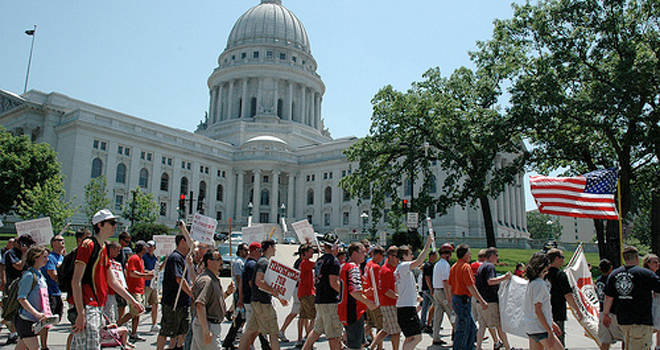So far, so good in the Wisconsin state Senate recalls, which as of midday have, according to reports, been proceeding smoothly.
Reid Magney, spokesman for the state Government Accountability Board, which oversees elections in the state, said that the GAB has not yet received any calls about incidents at any polling places, nor updates about turnout. The overall call volume to the GAB’s central office has been only low to medium — and coming from an interesting source for problems.
“We’ve had calls from people who want to know where they vote, and it turns out they don’t live in one of the Senate districts, so they’re unhappy about that,” said Magney. “And that’s what happens when you’ve got elections that happen in certain districts, but people in the media markets are seeing ads about it and not realizing who their senator is.”
As WisPolitics reports, city clerks in some municipalities say that turnout could be near the level of a presidential election — though this is not true across the board, with other being closer to the hotly-contested state Supreme Court election this past April.
UW-Milwaukee political science professor Tom Holbrook lives in one of the recall districts, where GOP state Sen. Alberta Darling is facing Democratic Rep. Sandy Pasch. (However, he informed TPM, the new redistricting map passed in the last few weeks by Republicans means that starting in 2012, he will be in the safe Democratic district of state Sen. Chris Larson. But for today, the recalls are taking place under the old map.)
“I live in a fairly Democratic precinct, and you can’t swing a dead cat without hitting a Sandy Pasch canvasser the last few days,” said Holbrook. “They are everywhere. Now, I have no idea if the same thing is true up in the more Republican neighborhoods with Darling canvassers. But the Pasch-affiliated groups are really out thick and strong.”
As for how high the turnout could get, Holbrook said there are two factors at work. “This is still just a Tuesday in August,” said Holbrook. “If you’re not contacted, it’s easy to forget there’s an election.”
On the other hand, he added: “There is a pretty substantial core of regular voters in Wisconsin. And if you’re one of those voters, both campaigns know that you vote, and they probably have a good idea of whether you’re going to vote for them or not, and they’ll contact you.
“We really just have no idea with this kind of election.”
UW-Madison political science professor Charles Franklin gave TPM his rough estimate for turnout among the voting-age population, though given the unusual nature of these elections any such prediction is only tentative. “We saw 35 percent in the Supreme Court race in April. I think we could go 40, and there are some sources in the state talking about it going in the mid-40s, which would be closer to November’s turnout.”
Based on available public polling, Franklin sees incumbent Republicans Dan Kapanke and Randy Hopper as the most vulnerable, with Luther Olsen and Alberta Darling as the next two close seats that Democrats could potentially grab away from the Republicans.
“But with the appropriate qualifiers,” Franklin added. “Who knows what’s going to happen?”
“The other thing is, is this a wave election, where the same force blows in the same direction today?” Franklin said. “Or have the individual candidates managed to turn them into separate campaigns, in which case it’s more like a coin toss for each campaign, instead of one flip for everyone?
“And we don’t know that at this point, given the lack of much polling.”






